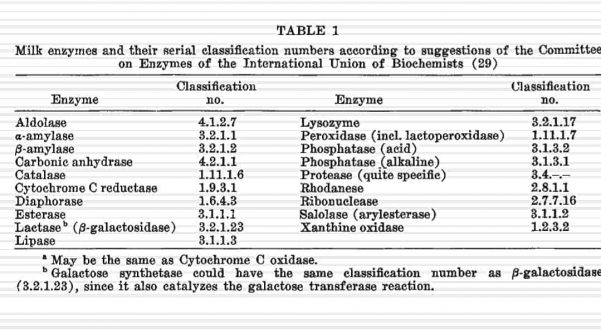Let’s get to know some of the enzymes that are found in unpasteurized raw milk.
Enzymes are destroyed in your gut as soon as they hit your stomach acid. If the milk is left alone, they aren’t destroyed, and they help influence the way the milk decomposes. This is useful if you make cheese.
Lactase
Lactase splits milk sugar (lactose) into the two simple sugars glucose and galactose. Mammals are the only class of animals who produce lactase in their milk.
Some people lose the ability to make lactase as they age, and must get it in their food or take supplements to avoid side effects caused by lactose intolerance. Various people in regions of Europe, Africa, India and the Middle East, through a helpful genetic mutation, produce the lactase in their intestinal tracts into their adult life. The lactase in raw milk, present from bacterial synthesis, appears to be destroyed by conventional processing (pasteurization and homogenization).
Alkaline Phosphatase
Phosphatase helps the body access phosphorus and calcium. Phosphatase hydrolyses uses water to break down phosphate esters, releasing phosphorus ions. Calcium absorption requires proper ratios of phosphorus and magnesium.
Phosphatase is completely destroyed at the lowest typical pasteurizing temperatures. Food processing companies test for the complete absence of phosphatase to determine if their pasteurization procedure was successful. Presumably, this process makes the absorption of phosphorus and calcium from milk difficult for our digestive systems.
Acid Phosphatase
Acid Phosphatase is akin to Alkaline Phosphatase. Acid Phosphatase works in environments with a lower pH than 7, while Alkaline Phosphatase works in environments higher than 7.
Amylase
Saliva and pancreatic juice contain Amylase to digest starch, glycogen, and other related carbohydrates. Raw milk also contains Amylase for the same reason. Amylase is commonly found in plants, as plants are mostly composed of carbohydrates. Amylase is rendered inactive by conventional milk processing (pasteurization and homogenization).
Catalase
Involved with waste management on the cellular level, catalase rids cells of hydrogen peroxide (H2O2), a chemical by-product of cellular metabolism. A strong oxidizer, H2O2 can wreak havoc in the cellular environment. Catalase quickly locks onto H2O2 and separates one oxygen atom from the molecule, producing oxygen and water. It appears to be rendered inactivate at temperatures above 158° F./70°C, well under the temperatures reached during pasteurization.
Lactoperoxidase
Identical to the peroxidase found in saliva and gastric juice, lactoperoxidase teams up with two other substances found in varying levels in milk (oxidized thiocyanate and hydrogen peroxide) to form an antimicrobial complex: Lysozyme.
Lactoperoxidase appears to be fairly heat resistant at normal pasteurization temperatures (roughly 50% is inactivated in milk held at 158° F./70°C. for 20 minutes) but is completely inactivated at 176°F./80°C. in just 5 minutes. Lysozyme, the anti-microbial mentioned above, is present in much lower quantities than lactoperoxidase.
Lipase
Actually a class of water-soluble enzymes, lipases break down fats (triglycerides) into fatty acids, and improve utilization of lipids throughout the body. Disruption of the fat globules, as in homogenization, can lead to rancidity if lipase isn’t destroyed first. Pasteurization accomplishes this, increasing the milk’s shelf life. Lipase enzymes are normally inactive in raw milk until triggered by the proper pH in the digestive tract.
Xanthine Oxidase
One major protein component of the milk fat globule membrane surrounding lipid droplets in milk is Xanthine Oxidase.
Xanthine Oxidase (XOD) exhibits a broad substrate specificity including aldehydes, purines and pteridines. Furthermore, this enzyme reduces oxygen to generate superoxide, hydrogen peroxide and reactive oxygen species (ROS). It also reduces nitrite to yield reactive nitrogen species (RNS), such as peroxynitrite and nitric oxide. Owing to its ability to generate RNS and ROS, XOD might play an important role as an antimicrobial agent in the neonatal gut, thereby complementing endogenous enzyme of the intestinal epithelium. [Sigma Aldrich]
Gamma-glutamyl Transferase
γ-Glutamyl transferase activity is high in human colostrum, and although activity decreases thereafter, considerable amounts of enzyme are present in transitional and mature milk (Brinkley et al., 1975; Patii and Rangnekar, 1982).
It has been suggested that the enzyme is localized in the Golgi apparatus and that it plays a role in the endo- and/or exocytotic transport of proteins. [Science Direct]
Other Dairy Enzymes
Thanks to April for finding this chart!

Various links:
Science Direct: Milk Enzyme
Science Direct: Milk xanthine oxidase: Properties and physiological roles
Science Direct: Gamma Glutamyl Group
Journal of Dairy Science: Milk Enzymes, Their Role and Significance (pdf)




